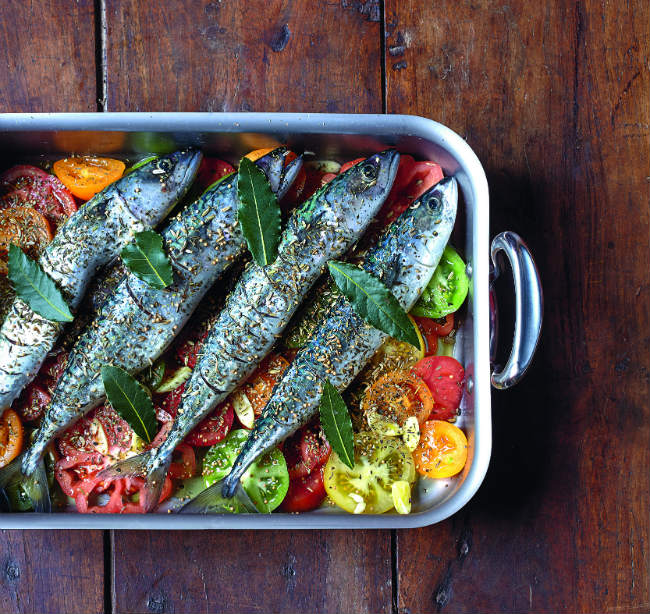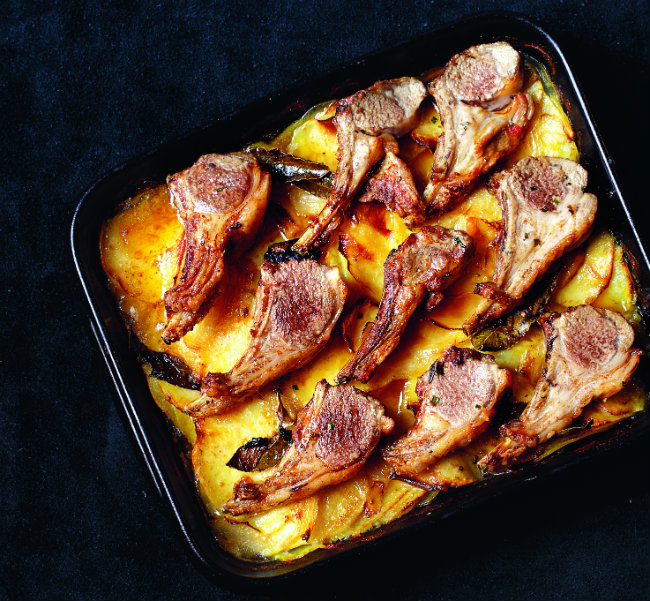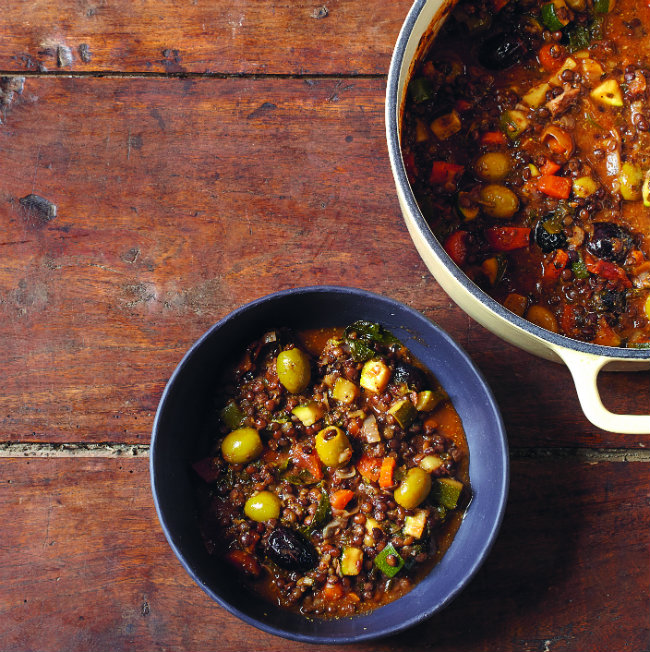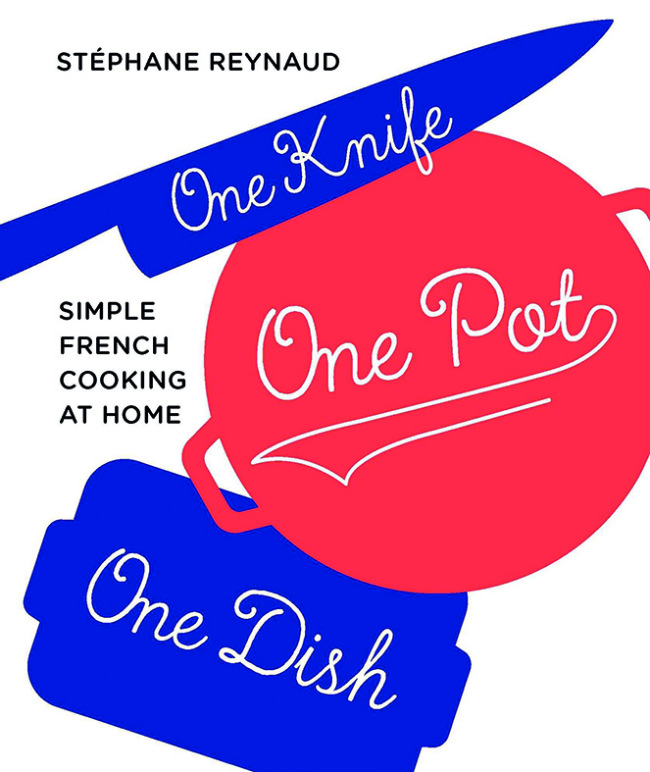All Hail the King of Pork: Interview with Stéphane Reynaud, Plus Recipes
Stéphane Reynaud has dropped the T-bomb: tofu. I brace myself for the “Gotcha” that is sure to follow. He is, after all, the swine-whisperer, proud scion of village butchers and bestselling author of Pork & Sons, the quintessential snout-to-tail pork ‘bible’. But the French chef couldn’t be more serious.
“I only recently discovered it, but smoked it’s surprisingly satisfying and filling – very pleasant,” he stands firm.
For one who built his reputation on rich, meat-laden concoctions, he is no crazed carnivore, feverishly extolling the virtues of a daily steak washed down with a ladle of stew and side of fricassée. Quite the opposite. A firm advocate of moderation, in the very same breath he recommends eating “good meat once a week; it’s more than sufficient”.
That said, his beloved pigs would swoop and soar overhead before he could be tempted by veganism. “If the entire population turned vegan it would be a catastrophe for humanity,” he doesn’t mince his words. But he has grown so fond of tofu, the bean curd has snuck its way into a couple of recipes in his latest cookbook: One Knife, One Pot, One Dish.
“I like to set myself a challenge in each of my books and tofu was my challenge this time. I have a tendency to put on weight, so I ate quite a lot of tofu to lose some. I don’t rule out anything. Everything people eat – want to eat – interests me.” His new bean curd-chomping diet was the source of endless jokes by his nearest and dearest, he laughs. And it’s little wonder.
Stéphane was knee-high to a grasshopper when he was initiated into the ancestral family butchery by his larger-than-life grandfather, a small village boucher in Ardèche. Shuttled off every school holiday to his beloved Pépé Barbe, he eagerly rolled up his sleeves and learned the ropes, only too happy to drag himself out of bed at the crack of dawn to accompany his grandpapa to the cattle market – and tuck into an early-morning steak-frites in the dim bowels of a smoke-filled bistro.
“We left at five in the morning – I was so excited, it was like a Christmas gift to go with him. During the winter, there was a lot of snow and we arrived in the village in the dark. Everything was closed, expect for a bistro, filled with everyone waiting for the market to open. At 6am I had steak-frites, surrounded by all those people and the smell of cigarettes and wine. I felt like an adult, even though I was only seven. Everybody was happy, it was full of noise, full of life. And I wanted to go back every week to have my steak for breakfast. I had the strongest feeling that I wanted to do that job, to cook.”
His baccalaureate under his belt, he enrolled at the prestigious Strasbourg Catering School – after initially being turned down. All else failing, he had toyed with veterinary studies, he says casually.
RESPECTFUL BUTCHERY
This (like his newfound penchant for tofu) may seem utterly at odds with his butchering roots and yet he insists care and love for the animal – every last morsel of it – is a fundamental tenet of ethical butchery and indeed gastronomy. Slaughtering should be an “act of kindness,” he explains. He recalls in hushed, reverent tones the care and benevolence bestowed by his grandfather on each animal in their final moments; likening the prelude to killing to a ceremony of sorts.
“I would follow him from farm to farm where he picked up the animals. For me, it was completely natural. He used to say to me, ‘See Stéphane, we’re going to find good animals, happy, well looked-after’. He spoke of the animals so lovingly. It’s paradoxical, but my grandfather loved the animals he killed. Before he killed a cow, he would walk it, let it graze by his side for a while. There was not a hint of aggression to the act.”
It may have seemed “completely natural”, but despite his early exposure to slaughtering, if only as a silent bystander, to this day Reynaud is unable to hurt, let alone kill, an animal. “I’m completely incapable of it,” he sets the record straight. “It’s complicated for me…” he trails off. “But I have no problem working on the animal once it’s dead. That’s my paradox.”
He is filled with the utmost regard for those who, like his grandfather, can expedite the deed with “respect” – a word he comes back to again and again. “You take a life to feed people, it is not something you should do lightly. You have to look after animals well, keep them happy from beginning to end,” continues Reynaud, who does not hide his disgust and frustration at unfettered, intensive farming. “It drives me insane,” he vents. “That’s the one thing that would convert me to vegetarianism. You have to be respectful and responsible. This is something people forgot for a long time, but the wellbeing of the animal is being put back at the centre of everything again.”
Fresh out of catering school, he honed his craft in various Parisian restaurants, all the while hankering for one of his own. But he did not hanker for long. Laughed out of every bank in the capital, the persistent chef eventually received a loan from a private lender and, barely 24, opened his first bistro. Monikered, with a typical spark of Reynaud humour, Au 14 Juillet, Il y a Toujours des Lampions, the eatery served up the hearty country fare on which he was raised – at a time when traditional bistros had fallen out of fashion.
It is the likes of 14 Juillet that have rekindled Parisians’ love for bistro culture and spearheaded the now thriving ‘bistronomy’ movement. He later launched the lauded Villa9Trois, which he recently sold to focus on his first British venture: the newly unveiled Tratra restaurant at the Boundary in East London.
Since his first tootle to the nearby pig farm in his grandpa’s beat-up van, pork has held an enduring fascination for him and inspired his very first cookbook, Pork & Sons, crammed with no fewer than 150 recipes and a veritable encyclopedia on the bountiful swine.
“Saucisson, ham, sausage… It’s a walking larder. It can feed a family all year-round,” he enthuses.
Part recipe book, part homage to his irrepressible grand-père and mentor, Pork & Sons, which was released in 2005, set out to pass on a rapidly dwindling craft to the next generation. Weaving recipes with family anecdotes and peppered with the great man’s pearls of wisdom – not to mention tongue-in-cheek doodles of piglets scampering across the pages – it was an instant hit and swiftly translated into 17 languages.
“The idea of ‘passing on’ was important to me. My children had never known the butcher shop, my uncle had taken it over but had just retired, so this was the end of the family business,” he says wistfully. “It was bittersweet for me. I thought I’d tell the story of the butcher’s that filled my childhood memories.”
Reynaud’s intimate and endearing tales (and pork-related fare) caught the discerning eye of domestic goddess Martha Stewart, who invited him to whip up his ancestral recipes on her TV show. The recipe book-cum-family saga earned him plaudits from the unlikeliest of places. “I had a two-page email from an Australian lady dissecting the book,” he stifles a chuckle. “She loved the stories, thanked me for everything, but never once mentioned the recipes,” he pauses, building up to his punchline. “Then she signed off, ‘PS: I am a vegetarian’. It was extraordinary. That’s the best compliment I’ve ever received on any of my books.”
His latest book, One Knife, One Pot, One Dish is quite a departure from the award-winning Pork & Sons, its follow-up Ripailles, or the daring Book of Tripe – dedicated entirely to the “unfairly shunned”, but decidedly pungent innards. Even he concedes that he was testing the limits of what readers, and his publisher, could stomach. “Once you’ve proved yourself to your publisher, he has a tendency to say yes to everything you suggest,” he muses, a deep belly laugh bubbling up. “I do like to provoke a reaction with each of my books. I love the freedom it gives me: every story, every recipe or comma is my own.”
SIMPLE GASTRONOMY
Devoid of anecdotes, the back-to-basics One Knife, One Pot, One Dish, is by far his most conventional (tofu excepted that is) cookbook. It was born, he confides, out a frustration. “I heard the same excuse all the time from my friends: ‘I would invite you over for dinner but I don’t know how to cook’,” he says in his best mock whine. “But I don’t expect Michelin-star food, I just want to have a nice time with friends,” he sighs. “There’s nothing more annoying. It’s not a competition. So now they have a book with recipes that only ask you to throw everything in one pot and that’s that.”
The tome is even dedicated to them (with a cheeky limerick to boot). From nachos slathered in chilly mince and rabbit in thyme to Osso Buco, the quick yet moreish recipes have tickled the fancy of his copains and the French public alike. So much so, he is already hard at work on a sequel of sorts. Emboldened by his dabbling with bean curd, he may well stray further into veggie (and even vegan) territory. But he remains firmly schtum on the specifics.
One thing is certain, he is not quite ready to sideline his beloved pork. “It has always been an obsession, a passion,” he booms. “I’m completely addicted.”
The following recipe extracts are taken from One Knife, One Pot, One Dish (published by Murdoch Books, £20) on sale now. Purchase the book on Amazon below:
MACKEREL WITH TOMATOES
Serves 4 | Preparation time 10 minutes | Cooking time 20 minutes
YOU’LL NEED…
1 baking dish
1 chopping board
160°C oven
INGREDIENTS
3 garlic cloves
1kg (2¼lbs) mixed tomatoes
4 good-looking mackerel, cleaned
1 tablespoon Herbes de Provence (mixed dried herbs)
5 bay leaves
150ml (5¼ oz) olive oil
Fine sea salt
1. Peel the garlic and slice it into rounds. Slice the tomatoes into rounds too. Slash the skin of the mackerel. 2. Lay the tomatoes in a baking dish, add the garlic and place the mackerel on top. 3. Sprinkle with herbs and bay leaves, drizzle with oil and season with sea salt.

Mackerel with Tomatoes
LAMB WITH BAY LEAF POTATOES
Serves 4 | Preparation time 20 minutes | Cooking time 45 minutes
YOU’LL NEED…
1 baking dish
1 chopping board
1 mandolin
180°C oven
INGREDIENTS
800g (1¾lbs) waxy potatoes (Bintje if possible)
4 onions
4 bay leaves
8 lamb cutlets
1 litre vegetable stock
Salt and pepper
1. Peel the potatoes and onions and slice thinly using a mandolin. 2. Make alternate layers of potato and onion in a baking dish and tuck the bay leaves in between. 3. Pour in the seasoned vegetable stock (the potatoes should be completely covered). Cook in the oven for 30 minutes. 4. Arrange the lamb cutlets on top of the vegetables, season and bake for a further 15 minutes.

Lamb with bay leaf potatoes
VEGGIE LENTILS
Serves 4 | Preparation time 10 minutes | Cooking time 20 minutes
YOU’LL NEED…
1 flameproof casserole dish
1 chopping board
Low heat
INGREDIENTS
3 French shallots
2 garlic cloves
2 carrots
1 courgette
3 ripe tomatoes
200g (7oz) blue-green Puy lentils
1 bunch flat-leaf (Italian) parsley
750ml (26½ oz) vegetable stock
50g (1¾oz) pitted green olives
50g (1¾oz) pitted dry black olives
1 tablespoon tomato paste (concentrated purée)
Salt and pepper
1. Peel and finely slice the shallots and garlic. Peel and cube the carrots. Cut the courgette and tomatoes into cubes. 2. Rinse the lentils. Chop the parsley. 3. Put the ingredients in a flameproof casserole dish, pour in the stock and cook on a low heat for 20 minutes. 4. Season with salt and pepper.
As seen in France Today magazine

Veggie lentils
Share to: Facebook Twitter LinkedIn Email
Leave a reply
Your email address will not be published. Required fields are marked *






